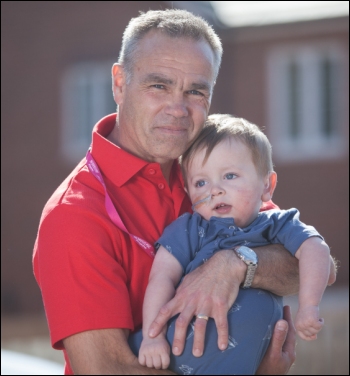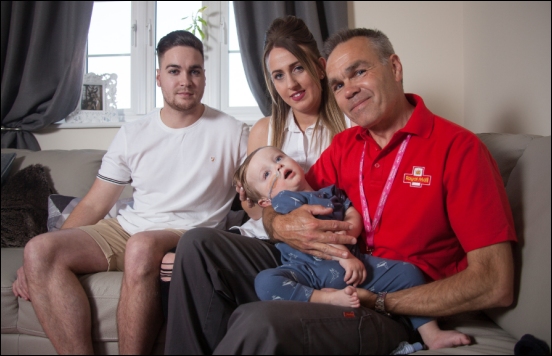A brave Burnham-On-Sea Royal Mail postman has walked more than 120 miles during an emotional fundraising walk from Edinburgh to London – despite suffering an ankle injury.
 Mark Penfold started his 500-mile trek last week, as we first reported here, which is raising money for the Lily Foundation, a charity extra special to him because his grandson, 18-month-old Frankie, suffers from life-limiting Mitochondrial Disease, which affects the central nervous system and has no known cure.
Mark Penfold started his 500-mile trek last week, as we first reported here, which is raising money for the Lily Foundation, a charity extra special to him because his grandson, 18-month-old Frankie, suffers from life-limiting Mitochondrial Disease, which affects the central nervous system and has no known cure.
Mark has raised over £15,200 so far and all the funds he collects, up to a maximum of £20,000, will also be matched by Royal Mail as part of the group’s celebration of 500 years of the postal service.
Speaking to Burnham-On-Sea.com last night (Wednesday) as he reached the quarter stage of his incredible walk, he said: “The first few days have gone really well, I have had so much incredible support from so many people – both back in Burnham-On-Sea and wider afield.”
“I have unfortunately picked up an ankle injury this week. I am experiencing some pain on the front of my foot and up the shin, but I won’t let it stop me.”
“The last few days I have walked up to 26 miles a day, meaning I’ve done 123 miles in total so far. I’m keen to walk an average of 20 miles a day to keep on schedule.”
“I’m only a week into it, but the support has been amazing, with many messages from people backing me. I know many people back in Burnham know about Frankie already and know me – but I’m keen to raise awareness about Mitochondrial Disease. I want as many people to be aware about it as possible so the help available to sufferers increases and hopefully a cure can be found in the future.”

Mark added: “Raising funds for the charity from my walk is important, but for me the bigger aim is raising awareness about Mitochondrial Disease and to spread the word and knowledge. I hope to feel exhausted at the end of the walk from talking about it so much.”
“The support has just been incredible. Yesterday I got chatting to a builder over breakfast and explained what I am doing. When he left, the wait came over to me and said the man had left a £20 donation even though he’d never met me before – amazing.”
Mark started his incredible walk from a postal delivery office in Edinburgh, and has been cheered on by colleagues and family, below, as he attempts to walk the former London to Edinburgh postal route, one of the oldest postal routes in the UK.

The Burnham-On-Sea postie says he is on track to finish by crossing Tower Bridge on 18th June, finishing at the Guild Hall in London, where he will join Royal Mail’s 500 year celebrations in the Capital.
Mark, 50, aims to walk around 20 miles a day, and added: “I am privileged to be following in the footsteps of ancient postal carriers to mark 500 years of the postal service.”
“Thinking of Frankie will spur me on to the finish line in London on 18th June 2016. I can’t thank Royal Mail, my colleagues and the Communications Workers Union enough, for the first class help, support and organisation it has taken to get me to the start today.”
“I am looking forward to seeing many other fellow postmen and women on my route, as well as Lily Foundation supporters.”
The Lily Foundation funds research to improve diagnosis and increase treatment options for Mitochondrial Disease, and ultimately find a cure. The charity also raises much needed awareness of the condition and support families affected by Mitochondrial Disease.
Also see:
![]() Click here to find out how to make donations towards Mark’s fundraising
Click here to find out how to make donations towards Mark’s fundraising
.What’s Mitochondrial Disease?
 Every twenty minutes a child is born who will develop Mitochondrial Disease by the age of 16.
Every twenty minutes a child is born who will develop Mitochondrial Disease by the age of 16.
There is no cure for this disease which is for many debilitating and life limiting like little Frankie.
When a person has Mitochondrial Disease the Mitochondria in the cells are not producing enough energy for the cells. Sometimes they do not work at all, and sometimes they are just not very efficient.
If a cell does not get enough energy (ATP) it cannot function properly. There is a huge variety in the symptoms and severity of Mitochondrial Disease. It depends on how many cells are affected, and where they are in the body.
Every person with Mitochondrial Disease is affected differently. Each individual affected will have a different combination of Mitochondria that are working and not working within each cell.
However, there are times when particular body systems are affected in a recognisable pattern and these have particular names, for example Alpers, Leigh’s disease, MELAS and MERRF. The commonest parts of the body affected are those that have the highest energy demands; brain, muscle, liver, heart and kidney.
If a lot of Mitochondria in the body are affected in the important body organs, like the brain, Mitochondrial disease can be very serious.
The symptoms of Mitochondrial Disease are usually progressive in body systems where the cells have a high demand for energy, such as brain cells.
Is there treatment? Unfortunately there is no cure for Mitochondrial Disease at present. Treatment is usually supportive to relieve the symptoms demonstrated, for example treating seizures with medication.
Doctors can also try to make the respiratory chain more efficient by using a co-factors and vitamins. Examples of these are Ubiquinone (Co-factor Q10), Thiamine and Riboflavin.
Some people find that using a special diet can help, and this varies depending on which part of the respiratory chain is affected. Any metabolic stress on the body, for example an illness, has the potential to cause a worsening or progression of Mitochondrial Disease, as the cells may not be able to cope with the extra demand placed upon them.
It is difficult to live in a world where all potential metabolic stresses are removed, but it is important to be aware, so that early medical advice and treatment of any illness can be started.
The Lily Foundation is currently supporting research initiatives at Guy’s and St Thomas’/Evelina Children’s Hospital, Newcastle University and Great Ormond Street Hospital/ Institute of Child Health and Sir John Radcliffe Hospital, Oxford.
By funding this work, it’s hope to enable doctors to get a better understanding of how mitochondria function. This will help identify new disease causing genes and improve the speed and accuracy of diagnosis. This will also lead to the development of effective treatment options, techniques to prevent transmission and ultimately to find a cure.







